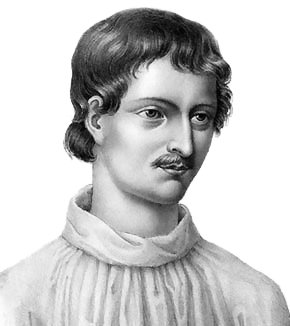
Giordano Bruno, the Benedictine monk found himself in conflict for his heretic views early on: at the age of 19 he removed the icons from his cell and opposed the adoration of Virgin Mary. The waters calmed down due to the leadership of the fraternity invoking Bruno’s young age. This argument, however, would not protect him for all his life…
In the first light of Ash Wednesday, on the first day of Lent, Giordano Bruno rode into Rome’s Campo de’ Fiori on a mule. He mounted the funeral pyre stripped naked and gagged with a leather bridle that kept him from spewing out his heresies to those who’ve come to witness his execution. While tied to the stake, Bruno could turn only his head away from the crucifix held up to his face. The pyre was then lit and the flames consumed him. Alas, one of the most original and interesting minds of the 16th century was burnt to ashes.
Giordano Bruno was in the abysm between the old world he had inherited from his pagan ancestors and the new world of scientific revolution. From the abysm he was in, he tried to revive the ancestral world of magic within the context of the new world of scientific revolution. Bruno is one of the figures in the history of ideas that I sympathize with, not so much for his ideas necessarily, but for his passion and mission. Bruno was a free thinker who cared little for the reactions of those who took offense at his ideas.
While some claim that he got in trouble for his scientific ideas, others have speculated that it was his carelessness, demeanor, tone, and language, not his controversial views. Let’s just say that people enjoy finding excuses for his horrific execution instead of acknowledging the fact that he was executed purely for his religious ideas and not for any of his speculations on multiple worlds and an infinite cosmos.
What saddens me the most is that people know Giordano Bruno mostly for how he died, executed by the Inquisition, rather than how his ideas serve as some of the precursors to modern scientific thought (the theory of relativity), and magic, specifically Thelema.
Giordano Bruno was not a “hero of science”, but a hero of free speech. He was not a poster-child for the religious persecution of science, but a poster-child for the Inquisition. Many associate Bruno with the “discovery” of Heliocentrism and that is such a gross misconception. To clarify: Philolaus, the 5th century BC Greek philosopher hypothesized that the Earth was a sphere that revolved daily around a mystical “central fire” that ruled our universe.
A couple of centuries later, Aristarchus of Samos identified that mystical central fire as the Sun. But because this heliocentric system was only in its embryonic states, no one could answer the mystifying question: “if the Earth does indeed move around the Sun, then why do the stars remain in the same position every night?”
And in the 2nd century AD, Ptolemy’s geocentrism came as a solution to this problem, by proposing that the Earth is in the center of the “universe” and everything else revolves around it. This was accepted as a scientific fact for about 1400 years. Until 1444, when Nicholas of Cusa questioned this fact. However, it took another 99 years to elaborate on this matter and with the publication of Nicolaus Copernicus’s De revolutionibus orbium coelestium libri VI (“Six Books Concerning the Revolutions of the Heavenly Orbs”) in 1543, the heliocentric system had finally come to a coherent reestablishment.
The most notable figure to endorse this system was Galileo Galilei not only because his discoveries with the telescope supported the Copernican heliocentric system, but also because it leads to his famous trial before the Inquisition in 1633.
But before Galileo, it was Bruno. Giordano Bruno merely advocated for the Copernican heliocentric system in a way that served his own theology which offended the church because it called into question the truth-value of Christ. So, who was, in fact, Giordano Bruno and what is this theology am I referring to?
Renaissance Man and Rebel Monk
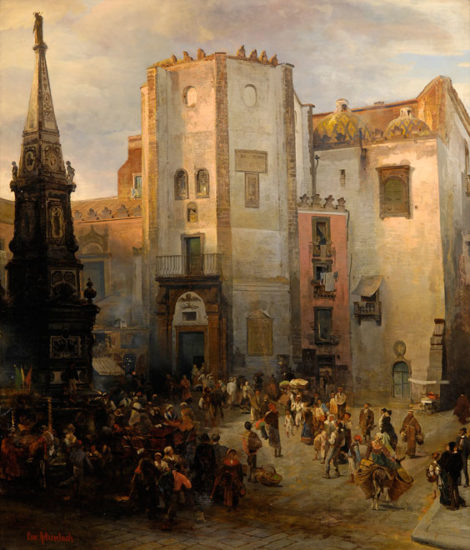
Pulsating life before on the Benedictine church San Domenico Maggiore in Naples, on the same named square, as depicted by German 19th-century artist Oswald Achenbach.
Filippo Bruno was born in 1548 in Nola (near Naples, Italy). In his youth, Bruno was privately tutored at the Augustinian Monastery in nearby Naples and he attended public lectures at Studium Generale. When he turned 17, he joined the Dominican Order at the monastery of San Domenico Maggiore in Naples. It is then that he took the name of Giordano after his metaphysics tutor, Giordano Crispo.
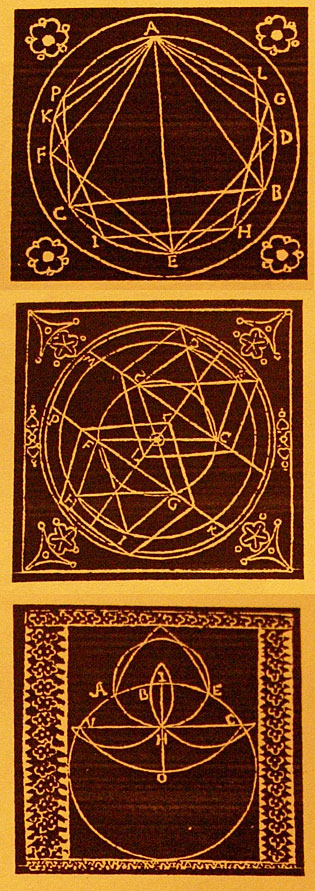
Three memory seals or “mnemonic devices” by Giordano Bruno. The basic techniques can be traced to classical antiquity and were a prominent feature in Western Hermetics and Alchemy. The similarity to bindrunes and sigills magick should be striking to most modern practitioners of the craft
At the age of 24, Giordano Bruno became an ordained priest known for his skill with the ancient art of memory. He has even traveled to Rome once, where he demonstrated his mnemonic system before Pope Pius V and Cardinal Rebiba. Bruno soon became known to the Church not only for his mnemonic system but for his free thinking as well. Bruno was passionate about works that were considered heretic and he wasn’t discreet about it.
This (and other things like defending the Arian heresy) caused the Church to prepare an indictment against him. Upon learning about this, Bruno fled Naples in an attempt to escape charges. He shed his religious habit and he was no longer recognized or acknowledged as a priest.
He spends the next 15 years wandering Europe and in 1579 he arrives at Geneva where he publishes an attack on distinguished professor Antoine de la Faye that leads to his arrest, alongside the printer. Instead of recanting, he continued to defend his publication.
Eventually, he left Geneva and went to France where he took his doctorate in theology and was elected to lecture in philosophy. He also became known for his prodigious memory that some of his contemporaries believed to be supernatural. His reputation reached the ears of King Henry III who summoned Bruno to the court. Bruno reported the following:
“I got me such a name that King Henry III summoned me one day to discover from me if the memory which I possessed was natural or acquired by magic art. I satisfied him that it did not come from sorcery but from organized knowledge; and, following this, I got a book on memory printed, entitled The Shadows of Ideas, which I dedicated to His Majesty. Forthwith he gave me an Extraordinary Lectureship with a salary.”
Bruno thrived under the protection of his powerful French patrons and went on to publish several works that were based on his own mnemonic models of organised knowledge and experience, such as: De umbris idearum (On the Shadows of Ideas, 1582), Ars Memoriae (The Art of Memory, 1582), and Cantus Circaeus (Circe’s Song, 1582).
Having received letters of recommendation from Henry III, Giordano Bruno went to England in April 1583 as a guest of the French ambassador at the time, Michel de Castelnau. There he frequented the Hermetic circle around John Dee and even lectured at Oxford. However, his attempt to gain a teaching position there was unsuccessful, largely due to his controversial views with the bishop of Oxford and George Abbot who later became Archbishop of Canterbury.
Abbot even mocked Bruno for supporting “the opinion of Copernicus that the Earth did go round, and the heavens did stand still; whereas in truth it was his own head which rather did run round, and his brains did not stand still”. Nevertheless, Bruno went on to publish his six “Italian Dialogues” and cosmological tracts such as La Cena de le Ceneri (The Ash Wednesday Supper, 1584), which seemed to have offended some people. If his controversial views weren’t upsetting enough, Bruno was also tactless, which resulted in a loss of support from his influential friends.
He spent his last years of wandering (1585-1592) in Germany, where he produced an abundance of magical works, such as De Magia (On Magic), Theses De Magia (Theses On Magic) and De Vinculis In Genere (A General Account of Bonding).
In 1591 his feats in the art of memory caught up with him once again, and he received an invitation to Venice from Giovanni Mocenigo, a patrician who wished to be instructed on mnemonics and suggested that he could apply for the vacant chair of mathematics at the University of Padua. The Inquisition at the time seemed to be more relaxed and because Venice was the most liberal Italian state, Bruno made the fatal decision of returning to Italy.
Bruno first went to Padua, where he failed to obtain the chair for mathematics – fun fact, this position was instead given to Galileo Galilei one year later. In March 1592, Bruno moved in with Mocenigo in Venice. Mocenigo became disenchanted with Bruno and denounced him to the Venetian Inquisition. Giordano Bruno was arrested on May 22nd, 1592. He was accused of blasphemy, heresy, and based on Mocenigo’s denunciation, he was also accused of personal misconduct and belief in the plurality of worlds.
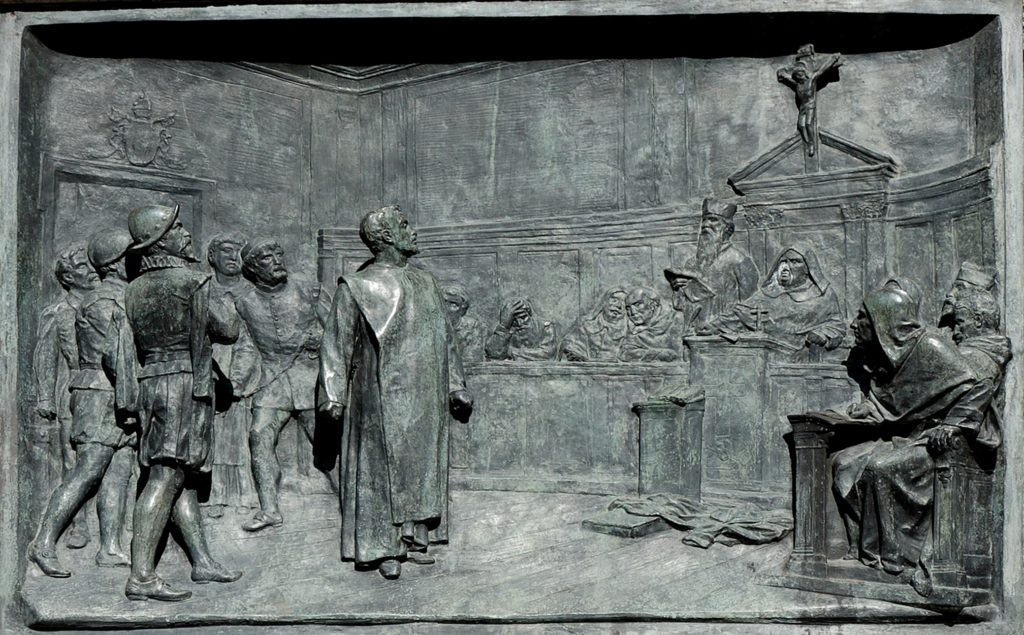
Bronze relief from Campo de’ Fiori, Rome by Ettore Ferrari in remembrance of Giordano Bruno’s trial by the Roman Inquisition.
The Burning of Giordano Bruno
Bruno’s trial in Rome lasted for 7 years in which he was held in confinement. The numerous charges against him included heresy, blasphemy, immoral conduct, which were made worse not by the basic doctrines of his cosmology and philosophy, but by his, again, lack of tact, such as calling Christ a “wretch” and declaring himself as an “enemy of the Mass”, according to Mocenigo’s account.
According to Luigi Firpo, the Roman Inquisition also charged Bruno with:
- holding opinions contrary to the Catholic faith and speaking against it and its ministers;
- holding opinions contrary to the Catholic faith about the Trinity, divinity of Christ, and Incarnation;
- holding opinions contrary to the Catholic faith pertaining to Jesus as Christ;
- holding opinions contrary to the Catholic faith regarding the virginity of Mary, mother of Jesus;
- holding opinions contrary to the Catholic faith about both Transubstantiation and Mass;
- claiming the existence of a plurality of worlds and their eternity;
- believing in metempsychosis and in the transmigration of the human soul into brutes;
- dealing in magics and divination.
Bruno was demanded a full recantation, but he refused. Because of this, Pope Clement VIII declared him a heretic and on January 20th, 1600 the Inquisition sentenced him to death. To this, Giordano Bruno replied with the following words:
“Perhaps you pronounce this sentence against me with greater fear than I receive it”.
On Ash Wednesday morning, February 17th, 1600, Bruno was burnt at the stake and his ashes were thrown in Tiber river. The Church records for that morning reported the following:
(Bruno) “was led by officers of the law to Campo de’ Fiori, and there, stripped naked and tied to the stake, he was burned alive, always accompanied by our company singing the litanies, and the comforters, up to the last, urging him to abandon his obstinacy, with which he ended his miserable and unhappy life.”
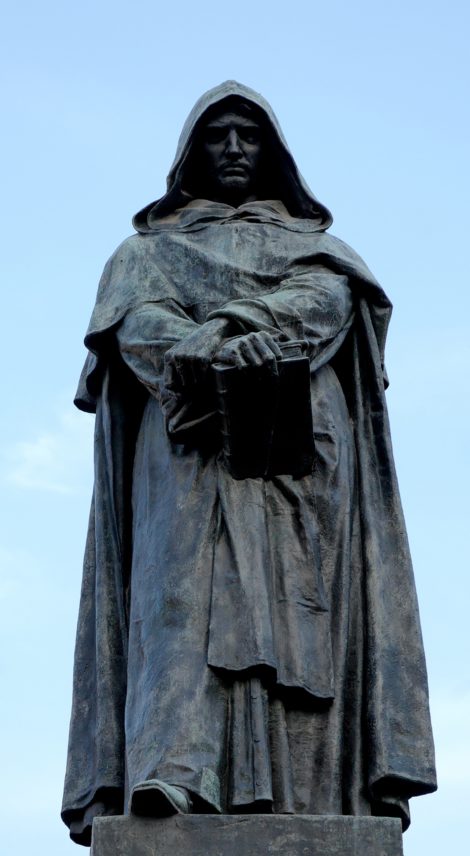
Giordano Bruno’s statue in Campo de’ Fiori, Rome, errected in 1889. Crafted by sculptor, Ettore Ferrari – Grand Master of the Italian Freemason Order “Grande Oriente d’Italia”. The unveiling of the sculpture on the site of Bruno’s execution was a response of the freemasons to Pope Leo XIII’s 1894 condemnation of masonry. Every year, on the anniversary of his execution, Rome’s mayor, masons, atheists, pagans among several other groups remember Bruno. The engravement says: “To Bruno – From the Age he Predicted – Here Where the Fire Burned”.
Bruno’s entire works were placed on the Index Librorum Prohibitorum in 1603. The burning of Giordano Bruno would haunt Cardinal Robert Bellarmine, the man most responsible for Bruno’s execution. His execution could’ve had political repercussions since the man shared his ideas with kings, dukes, and ambassadors in Protestant countries. In truth, his execution influenced how Cardinal Bellarmine handled the trial of Galileo Galilei three decades later. A document containing a summary of the legal proceedings against Bruno in Rome states:
“In the same rooms where Giordano Bruno was questioned, for the same important reasons of the relationship between science and faith, at the dawning of the new astronomy and at the decline of Aristotle’s philosophy, sixteen years later, Cardinal Bellarmino, who then contested Bruno’s heretical theses, summoned Galileo Galilei, who also faced a famous inquisitorial trial, which, luckily for him, ended with a simple abjuration.”
The Nolan Philosophy
Giordano Bruno did not die for his support of the Copernican heliocentric system – the Catholic Church did not even have an official position on the matter, therefore it couldn’t have been considered heresy. Instead, he died for his “theological errors” such as: “Christ was not God but merely an unusually skillful magician” or “the Holy Ghost is the soul of the world”, in other words: calling into question the truth-value of Christ and denying all forms of Christology.
Bruno was deeply influenced by Renaissance Hermeticism and Neoplatonism. His philosophy (Nolan philosophy, named after his hometown, Nola) was his own version of cosmology. Bruno’s “infinite worlds” heresy was inspired by the Copernican heliocentric system. As a natural philosopher, he interpreted the work of Copernicus and drew the conclusion that there is no upper limit to the universe, the universe was infinite with infinite solar systems similar to our own and perhaps even inhabited by beings like us.
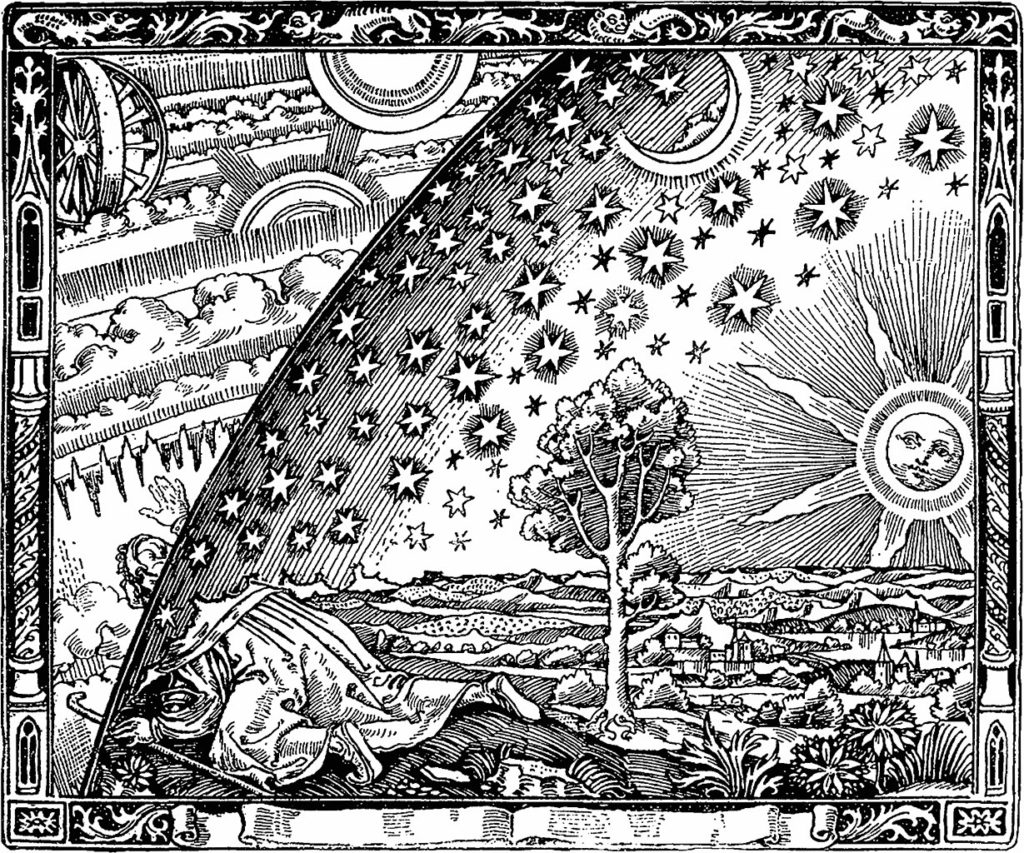
Engraving by an unknown artist, first printed in 1888 in Camille Flammarion’s book “L’atmosphère: Météorologie populaire“, often invoked to illustrate the medieval worldview: A flat world surrounded by several heavenly spheres. The original caption reads “A missionary of the Middle Ages tells that he had found the point where the sky and the Earth touch…”
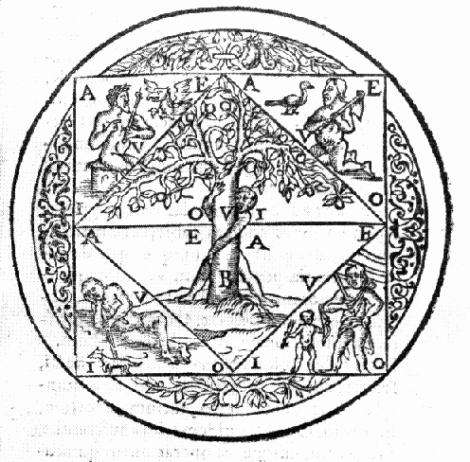
The four elements as depicted in one of Giordano Bruno’s mnemonic devices.
Bruno’s cosmos is infinite, homogeneous, and isotropic and it has planetary systems evenly distributed throughout. The entire cosmos consists of the same four elements: air, fire, earth, and water. He did not see the stars as made up from a separate quintessence. He also asserted that space and time are infinite, which further canceled Christian notions such as divine Creation.
The Sun was just another star, just like all the other stars were suns. He believed that the fundamental unit of the universe was a solar system and that there is an infinite number of solar systems in the universe, separated by Aether – pure air or “spiritus”. Through his words, we can understand his active principle, understanding of the elements and the infinitude of the universe as he perceived it:
“Whatever is an element of the infinite must be infinite also; hence both Earths and Suns are infinite in number. But the infinity of the former, is not greater than of the latter; nor where all are inhabited, are the inhabitants in greater proportion to the infinite than the stars themselves.”
From these scientific speculations, he drew his religious conclusion, that God is present in all of us and in all heavenly bodies. This causes him to call into question the truth-value of Christ: because if God is in all of us, why would there be a need for a mediator like Christ?
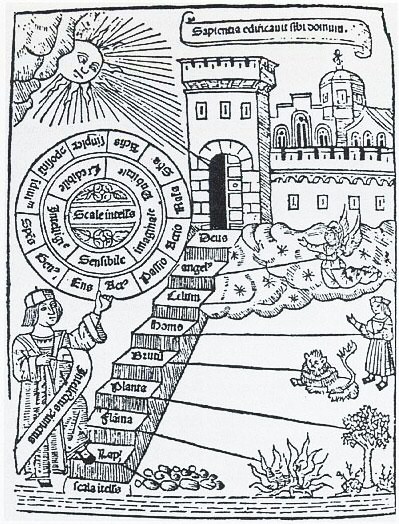
The Scala Naturae as depicted by Raimundus Lullus (Ramon Lull) showing the hierarchy of being. As opposed to orthodox clerical versions, hermeticians viewed the realms of being as grades of perfection and man free to move the stairs in both directions – maybe best expressed in Pico’s Oration on the Dignity of Man (Oratio de hominis dignitate).
Bruno’s universe had no top, bottom, center, beginning, or end, therefore, there could be no God at the “top” overseeing the Creation. But to Bruno this didn’t invalidate “God”; in fact, it made “God” accessible to anyone and anything at any point in time and space. This absolutely demolishes the clerical version of Scala Naturae (Great chain of being) where God was the permanent being at the top of Creation. In his De Magia, he identifies two scales on his chain of being: descending and ascending.
- Descending scale: “in all the panorama before our eyes, God acts on the gods; the gods act on the celestial or astral bodies, which are divine bodies; these act on the spirits who reside in and control the stars, one of which is the earth; the spirits act on the elements, the elements on the compounds, the compounds on the senses; the senses on the soul, and the soul on the whole animal.“
- Ascending scale: “is from the animal through the soul to the senses, through the senses to compounds, through compounds to the elements, through these to spirits, through the spirits in the elements to those in the stars, through these to the incorporeal gods who have an ethereal substance or body, through them to the soul of the world or the spirit of the universe; and through that to the contemplation of the one, most simple, best, greatest, incorporeal, absolute and self-sufficient being.”
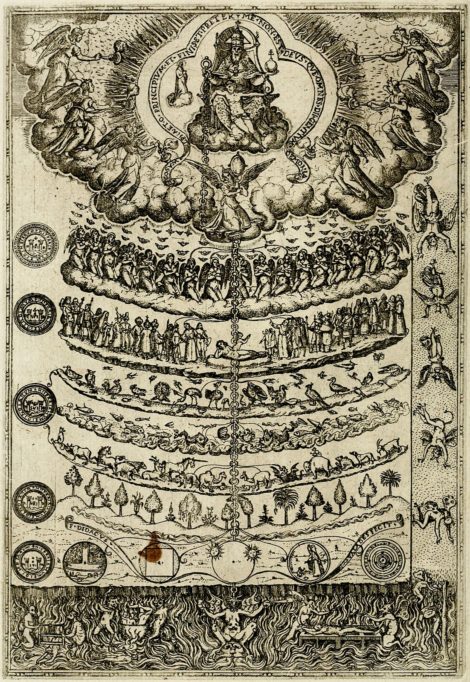
The Great Chain of Being as printed in 1579 in Rhetorica Christiana by Franciscan missionary Didacus Valades (Diego de Valadés). As opposed to Ramon Llully’s version the scale appears as a chain of a God-given order.
Bruno uses the Greek myth of Actaeon as an allegory to find not a moral meaning, but a divine one that further closes the gap. In this version of the myth, Actaeon goes hunting for a stag with his hounds in a forest, where he comes across the goddess Diana bathing in a river. He is mesmerized and gazes at the divine beauty, but the goddess punishes him by turning him into a stag.
Thus, the hunter becomes the hunted. His hounds devour him and Actaeon dies. Bruno interprets this myth as a metaphor for his pantheism. The prey that Actaeon seeks is the divine truth. He catches a glimpse of it when he comes across Diana and this encounter transforms him into that which he sought: the divine. He is then devoured by his hounds that represent the will and discursive intellect. This way, Actaeon becomes the heroic man. Bruno states the following:
“He saw himself transformed into that which he sought and realized that he himself had become a much-desired prey for his hounds, his thoughts. Because he had actually drawn the Godhead into himself, it was no longer necessary to seek them outside himself. Here, his life in the mad, sensuous, blind and fantastic world comes to an end, and from now on he leads a spiritual life. He lives the life of the gods.”
In other words, the active pursuit of the desired object transforms one into the object itself. This employs the concept of Eros as mystical love, in which the exchange of the phantasmatic images impresses the spirits of the subjects and the objects. Basically, through mystical love, A becomes B and B becomes A. This further develops Bruno’s Naturalistic Pantheism to reestablish the hierarchy of being.
God, which is pure actuality, from the top of the hierarchy, descends at the same time that Nature which is pure potentiality, at the bottom of the hierarchy ascends. When they meet, a phenomenon occurs, something called coincidentia oppositorum or unity of opposites, a concept that Bruno borrowed from Nicholas of Cusa (but my educational background in philosophy and love for my favorite Ancient Greek philosopher compel me to state that it was Heraclitus who first suggested this concept).
Since Bruno believed in an infinite universe in which he locates the divine in the natural and the natural in the divine, he is able to deduce that this unity of opposites happens at every single point in the universe.
Furthermore, he employs another concept from Nicholas of Cusa (which can also be tied back to Empedocles): “God is an infinite circle whose center is everywhere and whose circumference is nowhere.” Thus emerges the idea that this constant unity of opposites in an infinite universe is the state of being. Similar to this is one of the principles of Liber AL: “In the sphere I am everywhere the center, as she, the circumference, is nowhere found” (AL, II:3).
Because the divine is located in the natural and the natural is located in the divine and because there is no permanent being at the top of the hierarchy, there is no need for a creator – the anima mundi is creating itself general material forms that are intrinsic to it. Creation creates and is in itself created in the act of creating.
For Bruno, this means that understanding the divine means understanding nature. And you can understand nature by understanding the laws of the universe by employing an intellect and the concept of mystical love. So, the more the laws of the universe, the natural world, are assimilated through the heroic employment of mystical love, the more the intellect identifies with God and Nature.
Thus, the heroic enthusiast emerges, Actaeon, the man (intellect) who assimilates the laws of the universe through mystical love and becomes one with nature and the divine. The concept of the heroic enthusiast dissolves the need for a mediator, such as Christ, between nature and the divine.
It looks like Bruno was able to close the abysm in which he found himself, but he soon found that closing one abysm opens up another. Where the problem of finite beings in an infinite universe opens up a gap, for Bruno is a space for magic. Bruno asserts that for all actions to occur in the world, three conditions need to be met:
- an active power in an agent
- a passive power or disposition in a subject or patient “which is an aptitude in it not to resist or to render the action impossible”, which is the potency of matter.
- “an appropriate application, which is subject to the circumstances of time, place and other conditions.”
With this, he is able to form his concept of binding, as he wrote in his De Vinculis In Genere:
“Humans are bound in many ways. Of all the things which bind, certainly more of them bind humans than brute animals, and more of them bind those who have an active character than those who are dull witted; those who are well endowed in their faculties and powers are aware of more details, circumstances and purposes, and thus, they are moved by more desires.”
The way to bind is through Eros, mystical love. It’s all about dissolving the abysms in between, binding, and ultimately identifying with the object. In this way, the binder becomes bound, the manipulator becomes manipulated, and the reciprocal process of exchange occurs. Therefore, just like science, magic is another form of assimilating the laws of the universe and it leads to man’s transcendence through the identification with Nature and God.
“A bonding agent does not unite a soul to himself unless he has captured it; it is not captured unless it has been bound; he does not bind it unless he has joined himself to it; he is not joined to it unless he has approached it; he has not approached it unless he has moved; he does not move unless he is attracted; he is not attracted until after he has been inclined towards or turned away; he is not inclined towards unless he desires or wants; he does not desire unless he knows; he does not know unless the object contained in a species or an image is presented to the eyes or to the ears or to the gaze of an internal sense.”
Again, through Eros, we are able to do our will, our bidding: we manipulate or are manipulated, we are subjects or objects that exchange images. A bonding agent or a magician is able to manipulate these exchanges, or in other words: to establish links or bonds in order to bind.
Just like any bonding agent, a magician must know the laws of nature (which includes science), and in Bruno’s concept, the laws include his vision of the elements: gods are made of the pure substance of fire, airy and aqueous spirits are denser in body, so they are made of air and fire, and terrestrial spirits, which are the densest of bodies are made of water, air, and fire. In order to bind efficiently, one must know what appeals to these spirits and the elements they consists of.
“Therefore, he who knows how to bind needs to have an understanding of all things, or at least of the nature, inclination, habits, uses and purposes of the particular things that he is to bind.”
While a bonding agent is not always a magician, a magician is always a bonding agent. In his De Magia, Bruno identifies 10 meanings for the terms ‘magic’ and ‘magician’:
- Wise man: “for example, the Trismegistes among the Egyptians, the druids among the Gauls, the gymnosophists among the Indians, the cabalists among the Hebrews, the magi among the Persians (who were followers of Zoroaster), the sophists among the Greeks and the wise men among the Latins.”
- Magician: “someone who does wondrous things merely by manipulating active and passive powers, as occurs in chemistry, medicine and such fields; this is commonly called ‘natural magic’.”
- Prestidigitation: “(the type of) magic involves circumstances such that the actions of nature or of a higher intelligence occur in such a way as to excite wonderment by their appearances”.
- Natural magic: “magic (that) refers to what happens as a result of the powers of attraction and repulsion between things, for example, the pushes, motions and attractions due to magnets and such things, when all these actions are due not to active and passive qualities but rather to the spirit or soul existing in things.”
- Mathematical magic or occult philosophy: “the use of words, chants, calculations of numbers and times, images, figures, symbols, characters, or letters. This is a form of magic which is intermediate between the natural and the preternatural or the supernatural.”
- Theurgy: “prayers, dedications, incensings, sacrifices, resolutions and ceremonies directed to the gods, demons and heroes. Sometimes, this is done for the purpose of contacting a spirit itself to become its vessel and instrument in order to appear wise, although this wisdom can be easily removed, together with the spirit, by means of a drug. This is the magic of the hopeless, who become the vessels of evil demons, which they seek through their notorious art. On the other hand, this is sometimes done to command and control lower demons with the authority of higher demonic spirits, by honouring and entreating the latter while restricting the former with oaths and petitions.”
- Necromancy or Pythian magic: “the petition or invocation, not of the demons and heroes themselves, but through them, to call upon the souls of dead humans, in order to predict and know absent and future events, by taking their cadavers or parts thereof to some oracle. This type of magic, both in its subject matter and in its purpose, is called ‘necromancy’. If the body is not present, but the oracle is beseeched by invoking the spirit residing in its viscera with very active incantations, then this type of magic is properly called ‘Pythian’.”
- Wicked or poisonous magic: “incantations are associated with a person’s physical parts in any sense; garments, excrement, remnants, footprints and anything which is believed to have made some contact with the person. In that case, and if they are used to untie, fasten, or weaken, then this constitutes the type of magic called ‘wicked’, if it leads to evil. If it leads to good, it is to be counted among the medicines belonging to a certain method and type of medical practice. If it leads to final destruction and death, then it is called ‘poisonous magic’.”
- Diviners: “those who are able, for any reason, to predict distant and future events are said to be magicians. These are generally called ‘diviners’ because of their purpose. The primary groups of such magicians use either the four material principles, fire, air, water and earth, and they are thus called ‘pyromancers’, ‘hydromancers’, and ‘geomancers’, or they use the three objects of knowledge, the natural, mathematical and divine. There are also various other types of prophecy. For augerers, soothsayers and other such people make predictions from an inspection of natural or physical things. Geomancers make predictions in their own way by inspecting mathematical objects like numbers, letters and certain lines and figures, and also from the appearance, light and location of the planets and similar objects. Still others make predictions by using divine things, like sacred names, coincidental locations, brief calculations and persevering circumstances. In our day, these latter people are not called magicians, since, for us, the word ‘magic’ sounds bad and has an unworthy connotation. So this is not called magic but ‘prophecy’.”
- Any foolish evil-doer: “‘magic’ and ‘magician’ have a pejorative connotation which has not been included or examined in the above meanings. In this sense, a magician is any foolish evil-doer who is endowed with the power of helping or harming someone by means of a communication with, or even a pact with, a foul devil. “
His Mission, Or: Giordano Bruno, Aleister Crowley and Thelema

Giordano Bruno – Portrait. Engraving by Johann Georg Mentzel (1677-1743)
Giordano Bruno, the precursor of modern culture, was someone who constantly tried to reconcile opposites by filling in the gaps, more notably, by filling in the gap between the old pagan world and the new world of the scientific revolution. He did this by developing a cosmology and theology that filled in not only his personal voids, but that helped pave the way for both magicians and scientists today.
Bruno can be and is considered by some as a proto-Thelemic philosopher, largely for his use of mystical love in the practice of magic and binding. Perhaps for this reason he was included as a Gnostic Saint in Aleister Crowley’s Liber XV, the Gnostic Mass.
This is why I find it ironic that atheists push his image forward as their poster-child. Bruno was initially a priest and ultimately a magus that not only supported, but incorporated science into his system. But the problem for many was not that he fancied science, but the fact that he raised man from the bottom of the hierarchy of being and knocked off the permanent being at the top.
To this day, he is still as controversial as always to both scientists and magicians. His spirit is of that element that stirs up ontological conflicts, but which inspires many to think and speak freely, and to be as tolerant as he was to those who had no tolerance for him.
Bruno’s influence on magic is still subject to criticism today. Those who question it might’ve never asked themselves: if the divine is present in all of us and in all heavenly bodies as Bruno proposed, isn’t then every man and every woman a star? And if through intellect, will employs Eros, love, to bind, isn’t then love under will?

www.theoldcraft.com


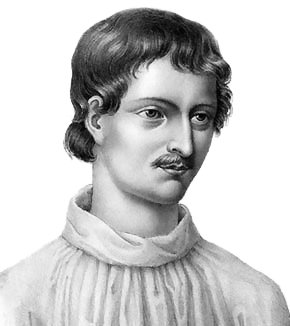
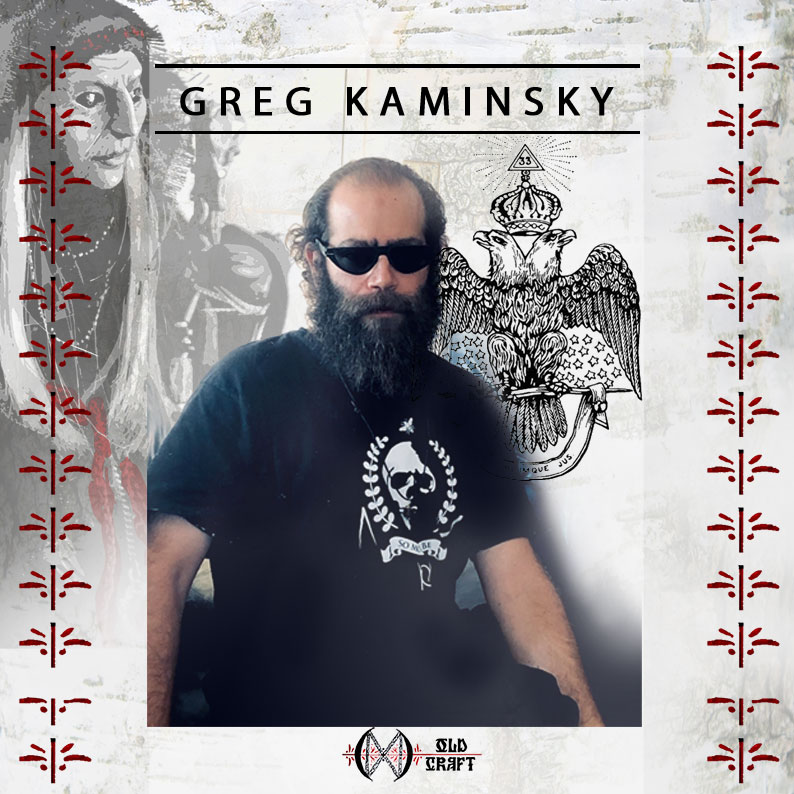

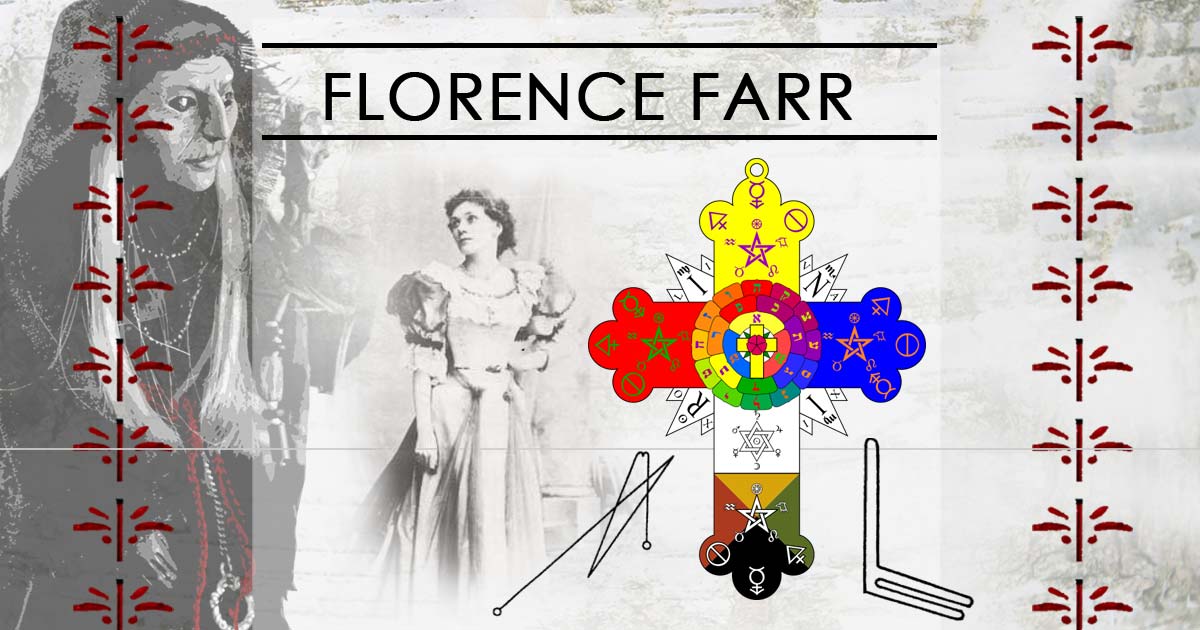
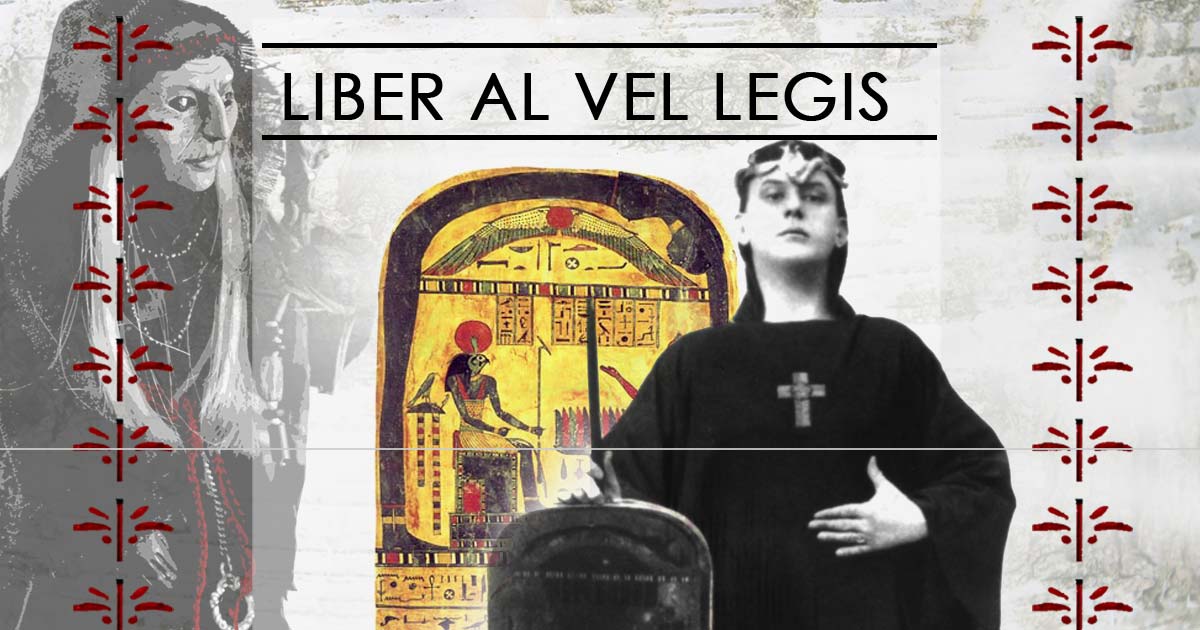
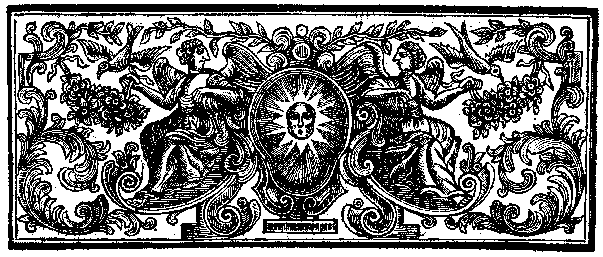
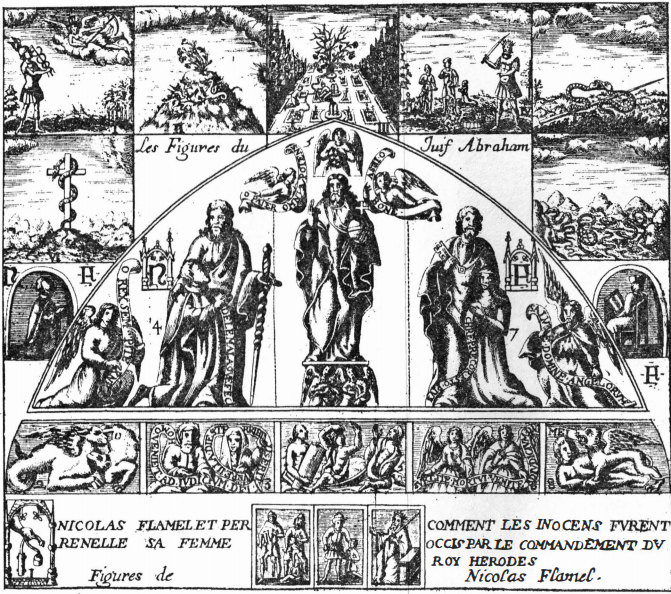
Ralph Edsell | May 30, 2020
|
Love your essay about Giordano Bruno. I am a researcher living in southern California
Sincerely, Ralph